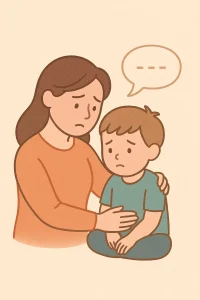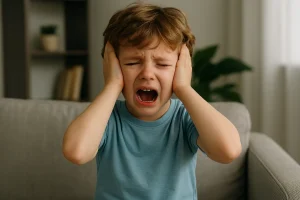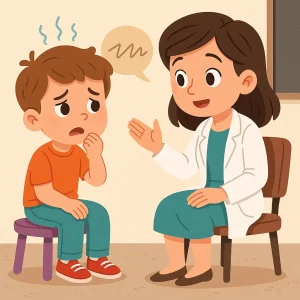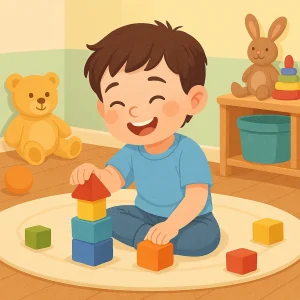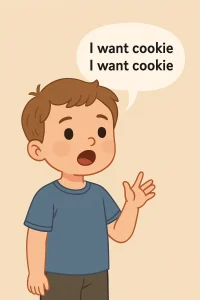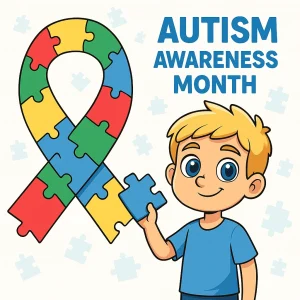ADHD and Cluttering: What’s the Connection in Speech Disorders?
By Wellness Hub
Last Updated: April 11, 2025
Have you ever wondered how the link between ADHD and cluttering might affect speech disorders? You’re not alone. Many parents, educators, and healthcare professionals seek to understand the intricate relationship between these two conditions. This curiosity stems from witnessing overlapping symptoms in individuals, particularly in children who face challenges in both speech fluency and maintaining attention.
Attention-Deficit/Hyperactivity Disorder (ADHD) is a neurodevelopmental disorder characterized by inattention, hyperactivity, and impulsivity. These symptoms significantly impact daily functioning and development. On the other hand, cluttering is a lesser-known speech disorder where an individual’s speech is excessively fast, irregular, or both, leading to speech that is difficult to understand.
What is ADHD?
Attention-Deficit/Hyperactivity Disorder (ADHD) is a common neurodevelopmental condition that affects millions of children worldwide, and often continues into adulthood. ADHD is characterized primarily by patterns of inattention, hyperactivity, and impulsivity that are more severe, frequent, or interfering than typically observed in individuals at a comparable level of development.
ADHD is not just about being energetic or unfocused occasionally—it is a diagnosed disorder that significantly impacts one’s ability to function daily. It’s diagnosed based on criteria outlined in the Diagnostic and Statistical Manual of Mental Disorders (DSM-5), used by healthcare professionals across the globe.
Symptoms of ADHD
The symptoms of ADHD are generally grouped into two categories of behavioral problems:
- Inattentiveness (not being able to keep focus):
- Difficulty maintaining focus on tasks or play activities
- Frequently sidetracked, forgetting details of daily routines
- Difficulty organizing tasks and activities
- Hyperactivity and Impulsivity:
- Fidgeting or tapping hands or feet, or squirming in seat
- Often leaves seat in situations when remaining seated is expected
- Feeling restless, often running about or climbing in situations where it is inappropriate
- Unable to play or engage in hobbies quietly
- Often “on the go,” acting as if “driven by a motor”
- Talking excessively
- Blurting out answers before a question has been completed, difficulty waiting for their turn
Common Challenges Faced by Individuals with ADHD
Living with ADHD can present numerous challenges, affecting all facets of life from school to relationships, and into adulthood with career and day-to-day functioning. Here are some common challenges faced by those with ADHD:
- Academic and Work Difficulties: Trouble staying on task, missing details, and difficulty managing time can lead to struggles in school and work environments.
- Social Challenges: Impulsivity and hyperactivity can be misunderstood by peers, leading to social isolation or difficulty in making and maintaining friendships.
- Emotional Regulation: Individuals with ADHD often experience emotions intensely and may have difficulty managing feelings, leading to quick temper flares and frustration.
- Executive Functioning: This includes challenges with planning, organizing, strategizing, paying attention to and remembering details, and managing time and space efficiently.
Know more about our article on Navigating Daily Challenges: Understanding ADHD in Adults
Understanding Cluttering
Cluttering is a lesser-known speech disorder that impacts the flow of speech, making it difficult for listeners to understand the speaker. Unlike stuttering, which is characterized by repeated or prolonged sounds, cluttering often involves an excessively fast and irregular speech pattern. This can create a “cluttered” or jumbled sound to speech that listeners find hard to decipher.
Definition of Cluttering as a Speech Disorder
Cluttering is defined by irregularities in the rhythm and rate of speech. People who clutter may speak very rapidly and unpredictably, with frequent stops and starts, or they might compress words together. It’s as if their speech is trying to keep up with their rapidly flowing thoughts. Unlike many other speech disorders, individuals who clutter are often unaware of their speaking patterns and how it affects their listeners.
Also read: Cluttering Speech Explained: Causes, Symptoms and Help
How Cluttering Manifests in Communication
Cluttering can manifest in various ways in everyday communication, making it challenging not only for the person speaking but also for those trying to understand them. Here are some common characteristics of how cluttering appears in speech:
- Rapid, Irregular Speech Pace: Speech may appear unusually fast or uneven. Listeners might feel that the speaker is rushing through their sentences without natural pauses.
- Excessive Fillers or Revisions: Frequent use of fillers (“um,” “uh,” “you know”) and corrections or revisions mid-sentence can disrupt the flow of communication.
- Telescoping of Words: This involves collapsing or shortening words, which can make speech sound slurred or mumbled.
- Disorganized Speech Structure: Individuals may exhibit poor planning in speech, making it difficult to follow their line of reasoning or narrative.
Examining the Link Between Cluttering and ADHD
Understanding the relationship between cluttering and ADHD involves delving into scientific research that explores how these two conditions may intersect. This exploration is crucial, as it can inform more targeted and effective intervention strategies for individuals facing challenges associated with both ADHD and cluttering.
Scientific Studies and Findings on the Relationship
Recent studies have begun to shed light on the potential connections between cluttering and ADHD. Research suggests that the neurological pathways involved in ADHD, which affect attention and executive functioning, might also influence speech production processes. For example, a study published in the Journal of Speech, Language, and Hearing Research found that children with ADHD are more likely to exhibit speech disfluencies than those without ADHD. These disfluencies are not limited to stuttering but also include behaviors typical of cluttering, such as rapid-fire speech and poor articulation.
How ADHD Might Contribute to Cluttering
The link between ADHD and cluttering can be understood through the lens of cognitive and behavioral manifestations associated with ADHD:
- Rapid Thought Processes: Individuals with ADHD often experience rapid and scattered thoughts. When these rapid thoughts are verbalized, they can manifest as cluttered speech, where the individual’s speech struggles to keep pace with their thoughts.
- Impulsivity: A hallmark of ADHD, impulsivity can also extend to speech. Individuals may speak without planning their words, leading to disorganized and hurried speech that is characteristic of cluttering.
- Attention Fluctuations: Variability in attention, which is common in ADHD, can make it difficult for individuals to maintain a steady pace and rhythm in their speech. This can contribute to the irregular speech patterns seen in cluttering.
- Executive Functioning Challenges: These include difficulties with planning, organizing, and prioritizing, which can directly impact the way an individual organizes their thoughts and, consequently, their speech output.
Impact of ADHD on Speech Patterns
When we consider ADHD, we often focus on its effects on behavior and learning. However, its impact on communication is profound and sometimes overlooked. Both children and adults with ADHD can experience specific speech issues that influence their social interactions and overall communication effectiveness. Understanding these speech patterns is essential for providing appropriate support and interventions.
Detailed Look at Speech Issues in Children and Adults with ADHD
ADHD affects speech in several ways, often due to the neurological and behavioral characteristics of the disorder. Here’s how:
- Disorganized Thought Processes: ADHD can cause thoughts to be fragmented or rapidly shifting, which can be reflected in how a person speaks. This might manifest as jumping from one topic to another without clear transitions, making it hard for listeners to follow.
- Impulsivity in Speech: Impulsivity, a common symptom of ADHD, can lead to interrupting others during conversation, blurting out responses without fully forming them, or speaking at inappropriate times.
- Hesitations and Pauses: While some individuals with ADHD speak rapidly and abruptly, others might exhibit frequent hesitations or pauses as they struggle to find the right words or lose their train of thought.
- Volume and Tone Regulation: Managing the volume and tone of speech can also be challenging. This can result in speech that is inappropriately loud or a speaking tone that might seem flat or unenthusiastic.
Examples of How ADHD Affects Communication
- Inconsistency in Conversations: Due to difficulties with attention and focus, a person with ADHD might not consistently follow a conversation, leading to responses that seem off-topic or unrelated.
- Difficulty with Turn-Taking: The impulsivity associated with ADHD makes it challenging for individuals to wait for their turn in conversations, which can disrupt social exchanges and lead to misunderstandings or conflicts.
- Poor Narrative Skills: Telling a story or relaying information in an organized, sequential manner can be difficult, which affects personal and academic interactions, particularly in narrative-driven tasks.
- Communication in Group Settings: Engaging in group discussions requires a level of communication fine ship that can be particularly challenging for those with ADHD, affecting their ability to participate effectively in educational or professional settings.
Treating Cluttering in Individuals with ADHD
Managing cluttering in individuals with ADHD requires a multi-faceted approach. Effective treatment not only addresses the speech disorder itself but also considers the broader cognitive and behavioral challenges associated with ADHD. Let’s explore some of the approaches and how they can make a significant difference in improving both speech clarity and overall communication.
Approaches to Manage Cluttering
- Individualized Speech Therapy: Each person’s experience with cluttering and ADHD is unique, making personalized therapy plans essential. Speech-language pathologists (SLPs) work to develop tailored strategies that focus on slowing the pace of speech, improving articulation, and teaching techniques to manage the flow of speech more effectively.
- Cognitive Behavioral Therapy (CBT): CBT can be beneficial, particularly for managing the aspects of ADHD that exacerbate cluttering. This type of therapy helps individuals become more aware of their speech patterns and the situations that trigger disfluencies, offering strategies to improve self-monitoring and control.
- Practice and Repetition: Regular practice is crucial in the management of cluttering. Structured exercises designed to slow speech rate, enhance clarity, and improve the organization of thoughts can help individuals communicate more effectively.
Role of Speech Therapy and Medications
Speech Therapy: Speech therapy plays a pivotal role in treating cluttering, especially when combined with ADHD. Therapists can help by:
- Teaching Techniques for Clear Speech: This includes strategies for pausing appropriately, stressing certain words for clarity, and using breath to control speech pace.
- Organizational Language Therapy: Helping individuals learn how to structure their thoughts more logically and clearly before speaking.
- Feedback and Modification: Continuous feedback during therapy sessions helps individuals recognize and correct their speech patterns.
Conclusion
Understanding ADHD and cluttering is key to effective management. These conditions can intertwine, making clear communication challenging. Early intervention and personalized treatment plans are crucial. At Wellness Hub, we offer expert guidance and tailored therapies to help you manage these conditions effectively. Don’t wait to seek help—professional advice can significantly improve quality of life and communication skills. Reach out today and start your journey toward clearer communication and better management of ADHD and cluttering. It’s a step towards a more confident and empowered you!
Frequently Asked Questions:
1. What is the link between ADHD and cluttering?
ADHD and cluttering often coexist because the rapid thought processes and impulsivity associated with ADHD can lead to disorganized speech patterns known as cluttering.
2. How can I tell if my child has cluttering instead of stuttering?
Cluttering is characterized by rapid, erratic speech that may seem jumbled, whereas stuttering usually involves repeated sounds or words and noticeable struggling to speak.
3. What are the first steps in treating ADHD and cluttering in children?
The first step is getting a comprehensive evaluation from a healthcare professional or a speech-language pathologist to confirm the diagnoses and develop a personalized treatment plan.
4. Can speech therapy really help kids with ADHD and cluttering?
Yes, speech therapy is highly effective for children with ADHD and cluttering, focusing on slowing down speech, improving articulation, and organizing thoughts more coherently.
5. What role do medications play in managing ADHD symptoms that affect speech?
Medications primarily prescribed for ADHD can help improve focus and reduce impulsivity, indirectly aiding in better management of cluttering symptoms.
6. Are there any specific exercises I can do at home to help my child with cluttering?
Yes, there are several exercises, such as practicing slow and deliberate speech, using metronomes to pace speech, and engaging in storytelling activities that can help manage cluttering at home.
7. How can I support my child’s speech therapy sessions at home?
Reinforce the strategies used during therapy by practicing with your child, providing positive feedback, and maintaining consistent routines for speech practice.
8. What technologies can assist children with ADHD and cluttering?
Various apps and tools designed for speech therapy can provide practice and feedback, helping children with ADHD and cluttering improve their communication skills.
9. Can ADHD and cluttering affect my child’s academic performance?
Yes, both ADHD and cluttering can impact academic performance due to difficulties with attention, communication, and processing speed, but with the right strategies, these challenges can be managed.
10. Where can I find more resources or support for managing my child’s ADHD and cluttering?
Visit Wellness Hub for a range of resources, expert advice, and community support to help manage ADHD and cluttering effectively.
About the Author:
Shravanaveena Gajula
M.Sc ., Speech and Language Pathology (5+ years of experience)
Shravanaveena Gajula is a dedicated Audiologist and Speech-Language Pathologist with a BASLP and an M.Sc in Speech and Language Pathology. With experience spanning multiple settings, including Wellness Hub and Ashray Akruti, Veena specializes in a wide range of disorders from developmental issues in children to speech and language assessments in adults. Her expertise includes parent counseling, managing speech sound and fluency disorders, and creating individualized therapy programs. Veena is also PROMPT certified and an author of several insightful blogs on speech and language pathology, aiming to educate and assist caregivers in supporting their loved ones.
Book your Free Consultation Today
Parent/Caregiver Info:
Client’s Details:
* Error Message
